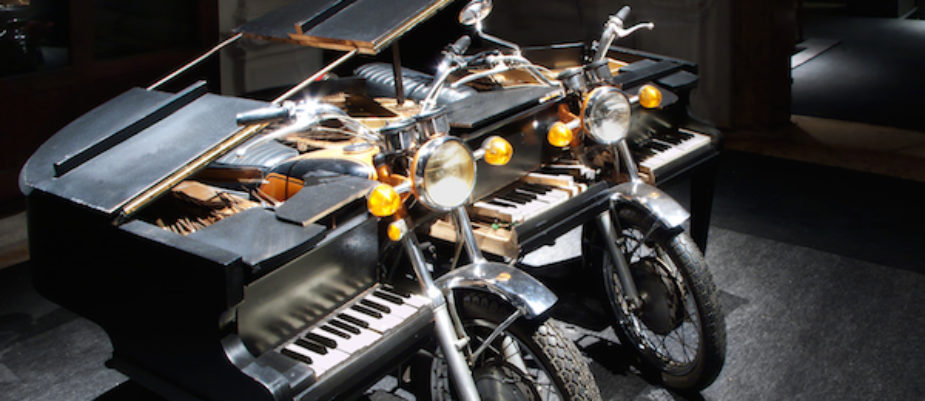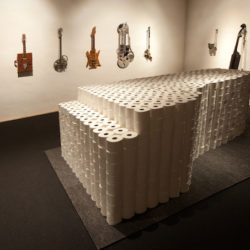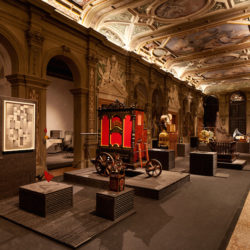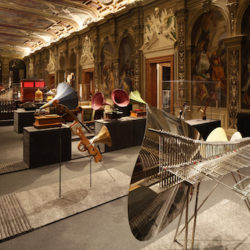
Art or Sound, is the new interesting, multisensorial and unordinary exhibition curated by Germano Celant at Fondazione Prada in Venice (until November 3rd). The title is intended as the encounter between two independent realms. The visitor is invited to identify the variety of ways through which art and sound have embarked on the same journey.
More than 180 artifacts (clocks and carillons, automata and musical machines, paintings and scores, sculptures and readymades, together with decorated, assembled, imaginary and silent musical instruments) and will occupy the two main floors of Ca’ Corner della Regina. For the first time the rooms on the second piano nobile are used: 800 sqm that have been restored as part of the program of renovation of the building undertaken by Fondazione Prada since 2011.
Art or Sound explores the relationship between art and sound and the way it has developed from the 16th century to the present day, examining the iconic aspects of musical instruments, the role of the artist-musician, and the areas in which the visual arts and music have come together. The exhibition sets out to investigate the relationship of symmetry and ambivalence that exists between works of art and sound objects. The intention is to offer a reinterpretation of the musical instrument that turns into a sculptural-visual entity and of the artworks that produce sound, in a continual encroachment and inversion of fields.
Seeking to document the transition between hearing and seeing and vice versa, the exhibition takes a historical perspective, starting out with music-themed paintings by Bartolomeo Veneto and Nicola Giolfino realized between 1520 and 1530, moving on to a series of musical instruments from the following century that, while producing sounds in a traditional manner, are characterized by an aesthetic and visual element that translates into a surprising plasticity. They range, for instance, from the inlaid marble guitars and viola created by Michele Antonio Grandi and Giovanni Battista Cassarini to a 17th-century cornett in the form of a serpent with a dragon’s head, an object that is unique in the originality of its external appearance and the quality of its craftsmanship and of the sounds it produces. These are followed by a series of 18th-century musical automata, such as the precious clocks in the form of a birdcage made by Swiss craftsman Pierre Jaquet-Droz, already famous all over Europe for the level of excellence he had achieved in the construction of musical mechanisms. The exhibition continues with automatic instruments of the 19th century like the pyrophone, the gas-powered instrument invented in 1870 by Frédéric Kastner that produces luminous signals when played. It also looks at research carried out in the field of synesthesia and at musical experiments that, from futurism to dadaism, have been made in integrated noises, such as Luigi Russolo’s famous intonarumori (1913), or vernacular sounds like Giacomo Balla’s Ciac Ciac (1914), while in With Hidden Noise (À bruit secret) (1916) Marcel Duchamp explored the dimension of silence in art for the first time.
Particular prominence is given to the original scores from the late 1950s written by John Cage, avant-garde composer and figure of reference for the Fluxus movement—represented in the exhibition by works by George Maciunas and Joe Jones—and for all the artists who have explored the principle of indeterminacy and chance in music and contemporary art. On the side of the object that tautologically communicates the sound produced during its construction or is capable of expressing itself autonomously once turned on, the exhibition presents the boxes of Robert Morris, Nam June Paik and Bruce Nauman, as well as kinetic sculptures made by artists like Stephan von Huene and Takis. The works of the Nouveaux Réalistes, such as Arman and Jean Tinguely, document phenomena of fortuitous destruction and assembly through musical instruments or devices, whilst Oracle (1962-65) by Robert Rauschenberg, in line with the same principles, is a sound environment constructed out of salvaged objects and commonly used materials.
Also on display in the exhibition are examples of appropriation of the image and form of the musical instrument, such as the pop assemblages.
The display system for “Art or Sound”, designed by global consultancy 2×4 led by Michael Rock, is informed by the structure of a musical score. The linear organization determines the arrangement of the bases and pedestals in the environment, while the objects and instruments in the exhibition act as individual elements of a musical notation. The floors and display stands on both floors of Ca’ Corner are covered with sound absorbing materials allowing visitors to focus on individual works.
Text by Gabriele Masi.
Captions
1,2, Artworks by Edward Kienholz, Milan Knížák, Tom Wesselmann and Stephan von Heune. Photo: Attilio Maranzano. Courtesy Fondazione Prada.
3, Hybrid Instruments, 1978-2002 by Ken Butler and Walter Marchetti. Musica da camera n° 211, 1991. Photo: Attilio Maranzano. Courtesy Fondazione Prada.
4, 5, Installation View of “Art or Sound”. Fondazione Prada. Photo: Attilio Maranzano. Courtesy Fondazione Prada.
Title of the exhibition: “Art or Sound”
Where: Ca’ Corner della Regina, Venice. Calle de Ca’ Corner, Santa Croce 2215 – 30135 Venice (Vaporetto Line 1 stops: San Stae and Rialto Mercato).
When: June 7 – November 3, 2014; from 10am to 6pm (Closed on Tuesdays).




















